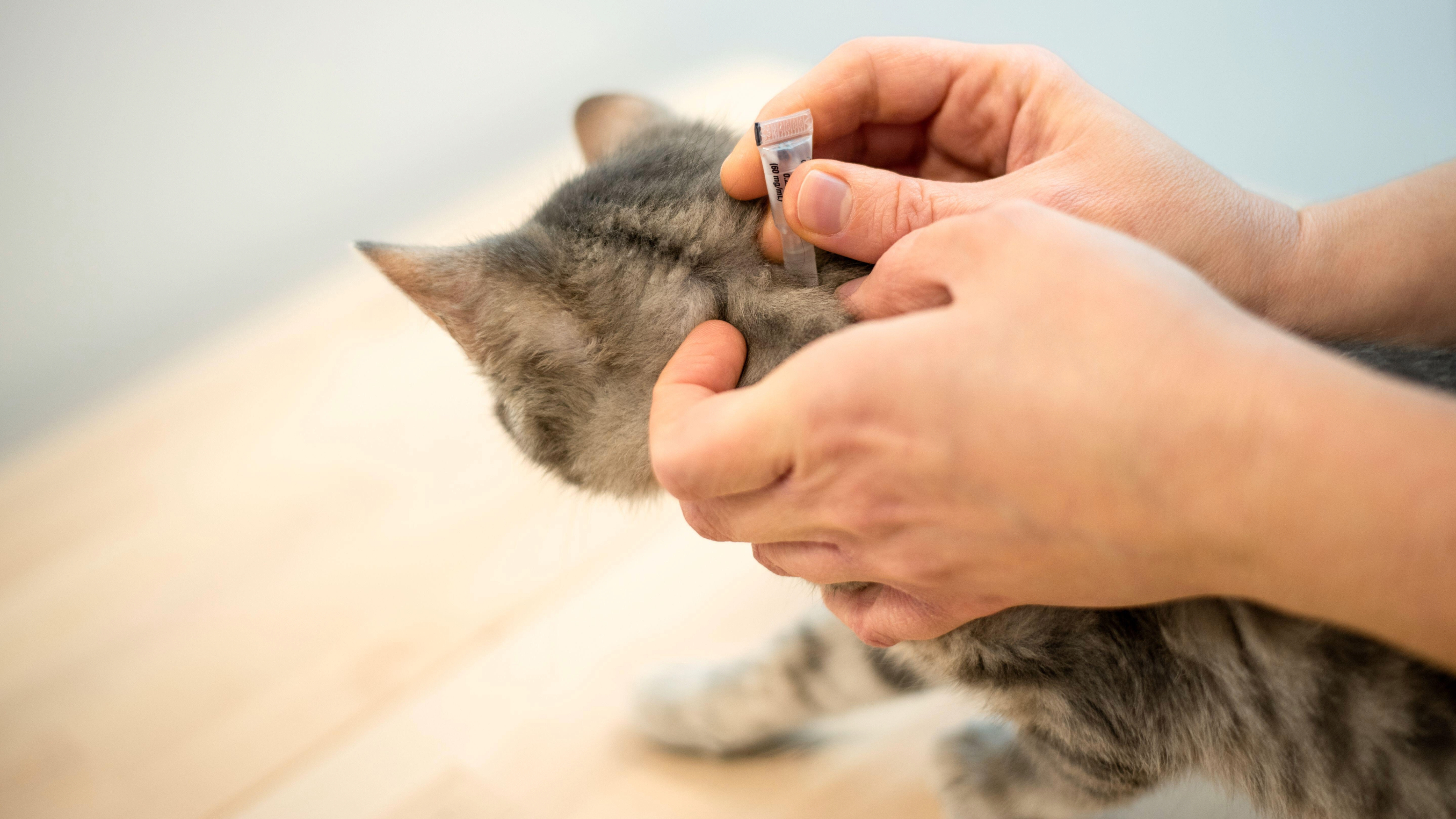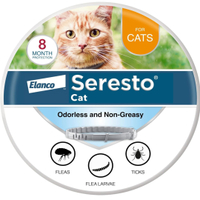How often do you treat cats for fleas?
How often do you treat cats for fleas? We spoke to a vet to find out!

How often do you treat cats for fleas? It's a question you may well be asking if you've just welcomed a new feline friend into your family. While it's easy to get sidetracked buying the best food, toys, and bedding, protecting your kitty from pesky parasites is one of the most important things you can do for their health and wellbeing.
While they may be small, fleas have the potential to create big problems. Carriers of all sorts of diseases, these little critters love setting up camp in our cat's coats and cause them all sorts of issues, including anemia and tapeworm. Thankfully, regularly using one of the best flea treatments for cats can stop these biting beasts in their tracks.
How often you treat your cat for fleas will depend on the type of product you use. A topical, for example, will need to be applied every 30 days, whereas one of the best flea collars for cats could last seven to eight months.
To help you figure out the best course of action for your cat, we spoke to expert vet Dr. Hannah Godfrey. Below, she explains the options when it comes to protecting your feline friend from fleas, the signs to be on the lookout for that suggest your cat may have an infestation, and why flea prevention is so critical for your cat's health.
How often do you treat cats for fleas?
If you have a feline fur baby, you may be wondering how often you need to treat them to prevent pesky parasites from setting up camp in their fur. According to Dr. Godfrey, the frequency with which you treat your cat for fleas will depend on whether you opt for a flea medicine vs flea collars.
"Certain flea collars will be effective for seven or eight months, while typical spot-on treatments are only effective for one month," she explains. "While you might think your cat doesn’t need flea treatment all year round, in this age of centrally heated homes, it’s common for fleas to be a year-round problem."
Our pick of the bunch when it comes to the best flea treatments for cats, this topical is fast-acting, long-lasting, waterproof and suitable for cats and kittens aged eight weeks and older.
How to tell if your cat has fleas

Not all cats with fleas will have symptoms, but as Dr. Godfrey explains below, there are some signs you can be on the lookout for.
PetsRadar Newsletter
Get the best advice, tips and top tech for your beloved Pets
"If your cat has fleas, you might see them crawling quickly through their fur," she says. "It’s easiest to spot them in sparse fur, white fur, or on their back end just above the base of their tail.
If you don’t see live fleas, that doesn’t mean they’re not there, so keep an eye out for flea dirt. Flea dirt is digested blood (or essentially flea poop) and looks like small black specks within the fur, and if dampened with wet cotton wool it looks dark red.
Finally, if your cat has fleas you might notice them scratching or overgrooming and they might develop scabs, rashes, or wounds."
If you've been wondering why is my cat overgrooming or scratching, it can be worth checking them over for fleas.
How to get rid of fleas
When it comes to the flea life cycle and how you can break it, treating your kitty on a regular basis is one of the best ways to protect them from fleas and ticks. But alongside regular treatments, there are other things you can do to.
"To get rid of your cat’s fleas, it’s important to treat them and all other in-contact pets with an effective and species-appropriate flea treatment," confirms Dr. Godfrey.
"Make sure you treat all pets at the same time, otherwise, you might find they jump from your treated pet to the safe haven of your untreated pet!"
However, as Dr. Godfrey points out, you'll also want to look beyond the flea collar, topicals, and tablets and also consider your home.
"Alongside treating your pets, you’ll also need to hot wash all removable soft furnishings and use a household flea spray to kill any fleas in the environment."
What is the best treatment for cat fleas?

From collars and tablets to shampoos and topicals, there are so many different products on the market claiming to be effective at killing fleas and preventing their return. But are some better than others? We asked Dr. Godfrey to share her thoughts.
"While it’s important to choose a vet-approved and effective product, it’s also important to choose a product that you can administer easily and regularly without too much fuss," she explains.
"Therefore, if you can’t tablet your cat, it’s not a good idea to commit to giving a flea tablet regularly, whereas if you’re likely to forget to give treatments, choosing a long-lasting flea collar may be better. The majority of my feline patients receive flea treatment as a spot-on every month."
Most pet parents choose spot-on treatments because they're easy to apply, but how do topical flea treatments work exactly? Topicals are applied monthly to the skin at the base of your cat's neck and the treatment spreads quickly across your fur friend's body, killing fleas on contact.
Topical flea treatments are convenient to apply and highly effective, but they only last 30 days and tend to be the most expensive option. If you're on a budget, a flea collar can be a great alternative.
Offering eight months of protection, this vet-recommended flea collar is non-greasy, comfortable to wear and comes with a breakaway feature that causes the collar to release if snagged.
Why is flea prevention important for cats?
Fleas can carry and transmit a whole host of diseases, which is why it's so important to keep your kitty protected.
"Fleas don’t just cause a bit of itching. If your cat has lots of fleas all feeding from them they can become severely anemic," Dr. Godfrey explains. "Even if your cat only has one or two fleas, if they have flea allergic dermatitis they can lose hair and end up with sore, scabby, and infected skin.
Another flea-related risk to be aware of is tapeworm. Fleas can often carry tapeworm larvae, which means that if cats ingest an infected flea while grooming, they can end up infected."
Applying a topical treatment or another effective option, like a flea collar, will help ensure your kitty stays happy and healthy.
Flea treatment not working? We recommend speaking with your vet who will be able to advise you on what to try next.

Dr Hannah Godfrey studied Veterinary Medicine at the Royal Veterinary College London. After graduating in 2011, Dr Godfrey went on to become a veterinary surgeon, conducting surgery consultations on a range of animals at a small independent practice in Cardiff, South Wales, UK. Dr Godfrey has a strong interest in soft tissue surgery. When she’s not helping animals back on their feet, Dr Godfrey writes a number of veterinary and animal-focused articles.

Kathryn is a freelance writer who has been a member of the PetsRadar family since it launched in 2020. Highly experienced in her field, she's driven by a desire to provide pet parents with accurate, timely, and informative content that enables them to provide their fur friends with everything they need to thrive. Kathryn works closely with vets and trainers to ensure all articles offer the most up-to-date information across a range of pet-related fields, from insights into health and behavior issues to tips on products and training. When she’s not busy crafting the perfect sentence for her features, buying guides and news pieces, she can be found hanging out with her family (which includes one super sassy cat), drinking copious amounts of Jasmine tea and reading all the books.


